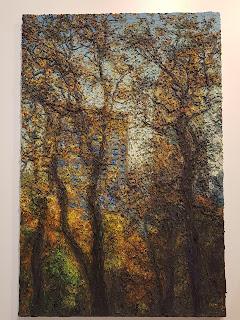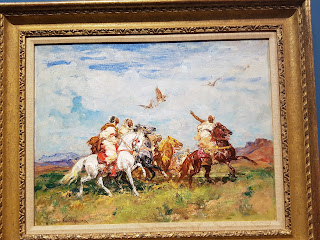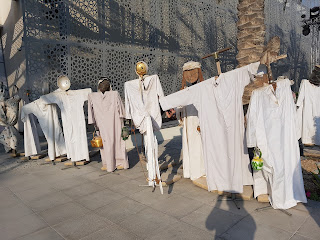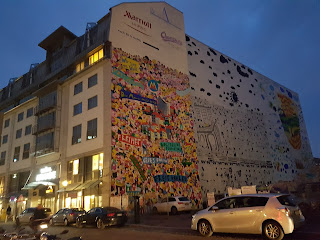***Art November from Leipzig to Abu Dhabi***
Mehr Licht! (More light!), the last words of Goethe, sums up most of what I wish to post this time.
When art and history are keen subjects visits to Europe's universities and museums are always a delight. Leipzig's illustrious list of alumni makes it one of our favourite destinations this time.
Leipzig University in the Free State of Saxony, Germany, is one of the world's oldest universities with an illustrious list of alumni that include Leibniz, Goethe, Ranke, Nietzsche, Wagner, Tycho Brahe, Georgius Agricola, Angela Merkel, and nine Nobel laureates.
Did I say Merkel? Yes! No matter how much she is loved or hated for her foreign policy or Christian indoctrinations; no matter how much we were warned about the rising 'right wing' sentiments in Saxonia, we did not find a trace of non-tolerance towards foreign visitors during our brief stay in Leipzig. For that matter, in all of Germany we trailed this time, we were pleasantly received by civilised folks. And I don't think it has much to do with good luck. It is plainly the truth!
Did I say Merkel? Yes! No matter how much she is loved or hated for her foreign policy or Christian indoctrinations; no matter how much we were warned about the rising 'right wing' sentiments in Saxonia, we did not find a trace of non-tolerance towards foreign visitors during our brief stay in Leipzig. For that matter, in all of Germany we trailed this time, we were pleasantly received by civilised folks. And I don't think it has much to do with good luck. It is plainly the truth!
 |
| Leipzig University Area: On the way to Auerbach’s Cellar (A wine bar that Goethe often visited). |
There were two other big events that took place in the capital city of Abu Dhabi in November - The opening of Louvre Abu Dhabi and Abu Dhabi Art's current edition.
 |
| Berlin: Pictoral representation of the stazi time adventure story of a family that united despite the wall between! |
 |
| Wall Sculpture: Steel sculpture Mauer by Eberhard Foest on Wilhelmstrasse in Berlin-Mitte, opposite the entrance to the Federal Ministry of Finance in Detlev-Rohwedder-Haus |
 |
| Blossom_Aie Weiwei_Porcelain_80x80x20cm (Lisson Gallery/Art Abu Dhabi 2017) |
 |
| Central Park_OH Chi-Gyun_Acrylic on canvas_2017 (Lee Hwaik Gallery/ArtAbuDhabi 2017) |
 |
| My imagination is no longer enough to comple my journey_Ali Chaaban_Silk on Carpet_170x120cm_2017 (Hafez Gallery/ArtAbuDhabi 2017 |
 |
| The Falconers_Henri Rousseau_Oil on canvas_49.5x64.7cm (Elmarsa/ArtAbuDhabi 2017) |
 |
| Punch Me Harder_Yoshitomo Nara_Acrylic, colored pencil_2000_222x19 (Whitestone Gallery China/Art Abu Dhabi 2017) |
 |
| Sudarshan Shetty please give a title to these beautiful works (made in found ceramics and recycled teak wood). |
 |
| Time, Love and the Workings of Anti-Love II #1_Lida Abdul |
 |
| Plug_Hassan Sharif_Plugs and copper wire_120x370cm_Gallery Isabelle van den Eynde, Dubai/Art Abu Dhabi 2017 |
 |
| Scarecrows by Abdullah Al-Saadi at Art Abu Dhabi Entrance |
Hitler's art
World War 2 gave Hitler and other senior Nazis the opportunity to plunder art from the museums of countries under Nazi occupation. This resulted in more art in Germany, than any other European country. [Did you see the the movie Monument's Man? It is a fiction on certain real events - an unlikely World War II platoon tasked to rescue art masterpieces from Nazi thieves and return them to their owners]. Over 5,000 works of art by the likes of Rubens, Goya and Rembrandt were sent back to Berlin. History is not what the movies tell. There is more art than what one may be able to document and showcase in museums. For this you need a nose for art news and past. Studying Hitler, helps us open our eyes to authoritarian philosophies and art.
Hitler, like most other dictators, preferred the romantic form of art. He stated that a finished picture should never display anguish, distress or pain. They had to be realistic and heroic. Hitler believed that good artists should use colour in their paintings that “was different to those perceived in Nature by the normal eye.” Hitler considered himself to be very knowledgeable with regards to art and effectively decided that there were two forms of art – un-German degenerate art of the likes of Pablo Picasso and classical realistic art that represented all that was good about Nazi Germany and Germans.
Weimar Germany was famous for the artists that worked there. Various forms of art excelled in Weimar – expressionism, Dada, cubism and impressionism. The focal point in Germany of the art world’s attention was the Bauhaus where artists such as Paul Klee, Wassily Kandinsky and George Grosz all worked.
Hitler had stated clearly in ‘Mein Kampf’ where his thoughts lay with regards to modern art as found in Dada and cubism: “This art is the sick production of crazy people. Pity the people who are no longer able to control this sickness.”
One man calling another sick is not a strange phenomenon. Thanks to Nietzsche, in Kritische Studienausgabe) for saying this:
“Main thought! The individual himself is a fallacy. Everything which happens in us is in itself something else which we do not know. ‘The individual’ is merely a sum of conscious feelings and judgments and misconceptions, a belief, a piece of the true life system or many pieces thought together and spun together, a ‘unity’, that doesn’t hold together. We are buds on a single tree—what do we know about what can become of us from the interests of the tree! But we have a consciousness as though we would and should be everything, a phantasy of ‘I’ and all ‘not I.’ Stop feeling oneself as this phantastic ego! Learn gradually to discard the supposed individual! Discover the fallacies of the ego! Recognize egoism as fallacy! The opposite is not to be understood as altruism! This would be love of other supposed individuals! No! Get beyond ‘myself’ and ‘yourself’! Experience cosmically!”
Leipzig's new and rising scene of art is interesting. Check pictures for details.
Back from Germany, we attended the opening of 'Arsnecopinata', a German artist who currently lives in Abu Dhabi. It was her debut solo, and runs until December 6, 2017. Here is the link to her Interview by Henosis. Please checkout her artworks on her blog or page.
Manarat Al Saadiyat
Louvre may need a separate post as I can comment on it only after a visit. I have heard mixed comments form people who have been there. Historical milestone for sure but this post needs to wait a little longer.
Art Abu Dhabi listed 43 galleries this year.
The event was divided into 4 categories:
1. Modern & Contemporary: Defined by the organisers as 'galleries open for more than seven years' (rather than the conventional art world definitions of ‘modern’ meaning art created roughly between the 1860s and 1960s), and ‘contemporary’ here means art from the present day and striking in some way. In practice these galleries showed some known names.
2. Bidaya (New galleries) – Bidaya means ‘beginning’ in Arabic and broadly speaking - an emerging art scene.
3. Solo Projects: Meem Gallery, showed a single monumental work by Dia Azzawi. (About which there is more to read below.)
4. Focus: Beyond Territory. A curated category - of a group of inter-generational artists and major projects from both emerging and leading galleries. Or in other words, an international platform for early- and mid-career artists selected by the curator, Dr Omar Kholeif (a senior curator at Chicago’s Museum of Contemporary Art). Seven galleries featured here include Galerist (Istanbul); In Situ – Fabienne Leclerc (Paris); Jhaveri Contemporary (Mumbai); Marian Goodman Gallery (New York, Paris, London); Sprüth Mager (London, Berlin, Los Angeles) and The Third Line Gallery and Gallery Isabelle van den Eynde from Dubai.
The first artwork that caught my eye was a largely monochrome 2.5 x 15m work which reminded at once of Picasso's Guernica. Upon closer look, the work was found to be by Dia Al-Azzawi, 78-year-old Iraqi Master who lives in London. It was a war scene. And no wonder Financial Times calls him the Iraqi Picasso.
Spray-painted in murals, wielded on anti-war banners, and even once hung as a tapestry at the United Nations, Pablo Picasso’s Guernica is perhaps the world’s most famous political artwork. It was commissioned by the struggling Spanish Republican government to produce a work depicting the bombing for the 1937 World Fair in Paris. It was clearly a propaganda artwork. But it has transcended time. Immortal as war, itself.
Guernica and Nachleben der Antike
Guernica was inspired by a Roman frieze. Art studies mention this clearly. During the spring of 1937, as Picasso worked tirelessly on the 3.49 m x 7.77 m Guernica at his Parisian studio, conjuring up images of despair, destruction and fratricidal violence to capture the tragedy of the Spanish Civil War, the basement of the National Archaeological Museum in Madrid had become a bunker where many of the artworks he had long admired were being stored away to keep them safe from the bombings. Among them was a Roman sarcophagus decorated with a Greek family tragedy, which unfolds on an elongated frieze in a sudden explosion of violence rippling out in chiastic movements. In the center is Orestes who, having just slayed his mother Clitemnestra and her lover to avenge the assassination of his father Agamennon, begins to ponder the consequences of his atrocious crime. As witnesses recoil in horror, the Furies, awaken by the blood spilled in matricide, initiate their relentless pursuit of the killer. Before being moved to the Madrid museum in the nineteenth century, this sarcophagus had captivated visitors to the medieval Castilian church where it had been reused in a Christian burial for over eight hundred years, giving way to one of the most complex and fascinating cases of Nachleben der Antike in the history of art as its imagery became the source of inspiration for artists confronted with the task of staging scenes of family crime and ritual murder, such as the sacrifice of Isaac or the killing of Abel.
Coming back to Art Abu Dhabi's Meem Gallery stand with Dia Azzawi, one can imagine how words, time, war, lines and art transcends time and inspiration to become immortal.
Hear Azzawi in his brief chat filmed by Tate Modern, few years ago.
Scroll down for more pictures form this month.
Thank you for travelling and reading deeply to stay inspired in the stories that enchanted certain selected humans to become artists.
Until next trip.
Mehr Licht!
- B'lu
PS: Berlin and Prague stories following shortly.








No comments:
Post a Comment